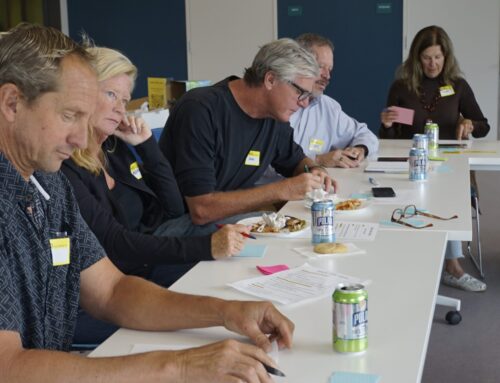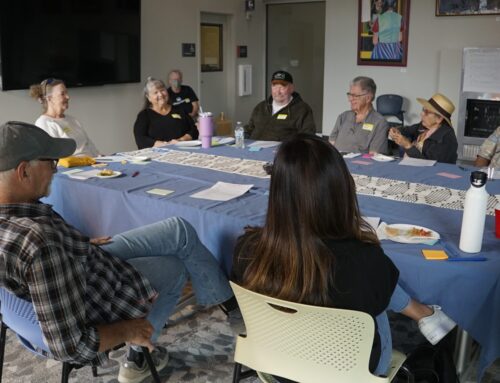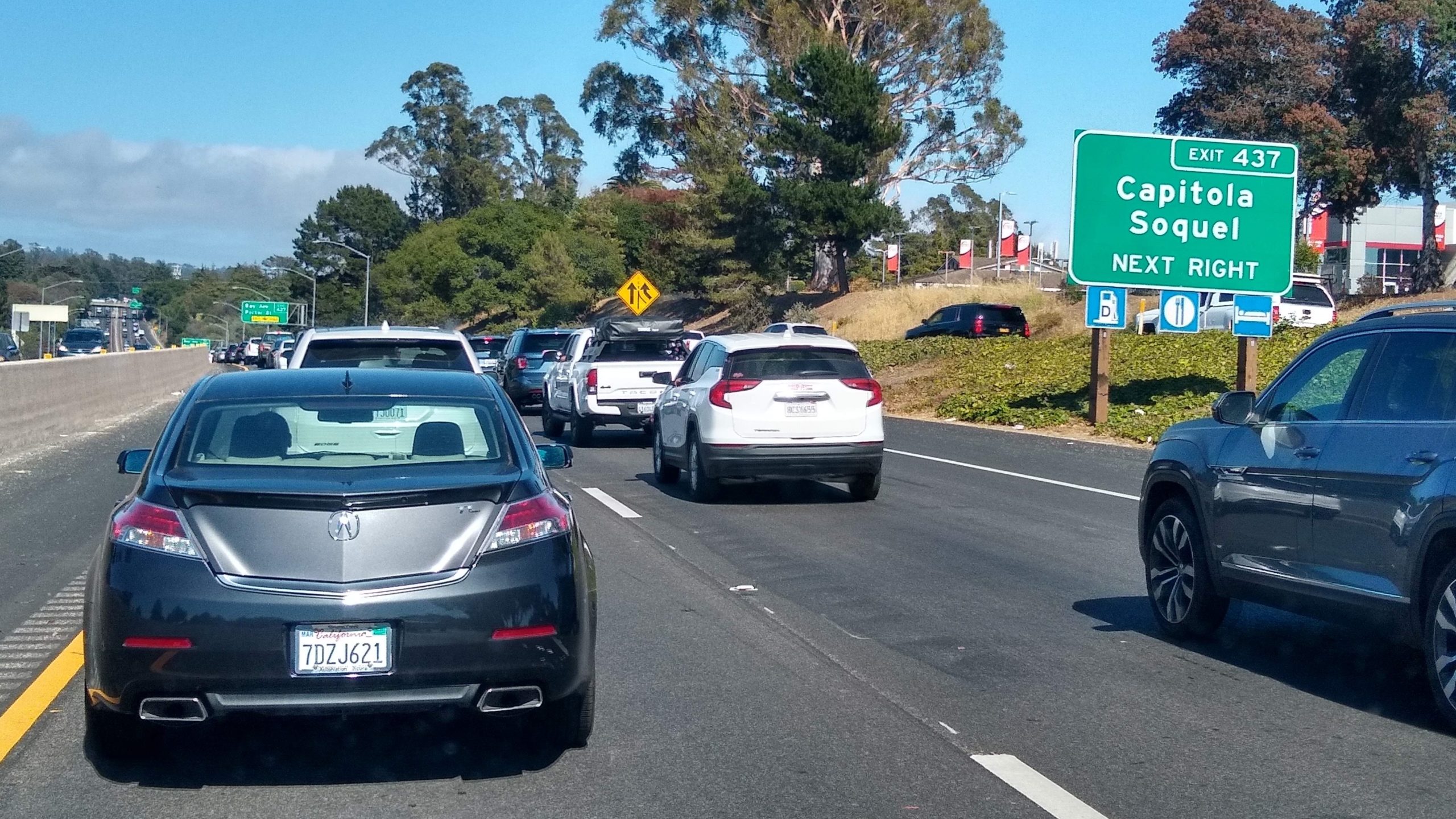
Work is expected to start this fall to widen Highway 1 from Bay Avenue in Capitola to Morrissey Boulevard in Santa Cruz. (Stephen Baxter — Santa Cruz Local file)
SANTA CRUZ >> Plans to widen Highway 1 from Santa Cruz to Aptos and create new overcrossings for cyclists and walkers were advanced by the Santa Cruz Regional Transportation Commission on Thursday.
The plans include improvements for walkers and cyclists on the Capitola Avenue bridge over Highway 1, as well as new footbridges over Highway at Chanticleer Avenue in Live Oak and at Mar Vista Drive in Aptos.
The first phase of work is expected to start this fall from Morrissey Boulevard in Santa Cruz to Bay Avenue in Capitola.
Thursday, transportation commissioners voted unanimously to spend $1.8 million from Measure D money to pay for increased costs of the first phase of the project. Santa Cruz County voters approved Measure D in 2016 to pay for transportation projects.
The commissioners also allowed commission staff to amend an agreement with Caltrans to get construction bids for the project’s second phase.
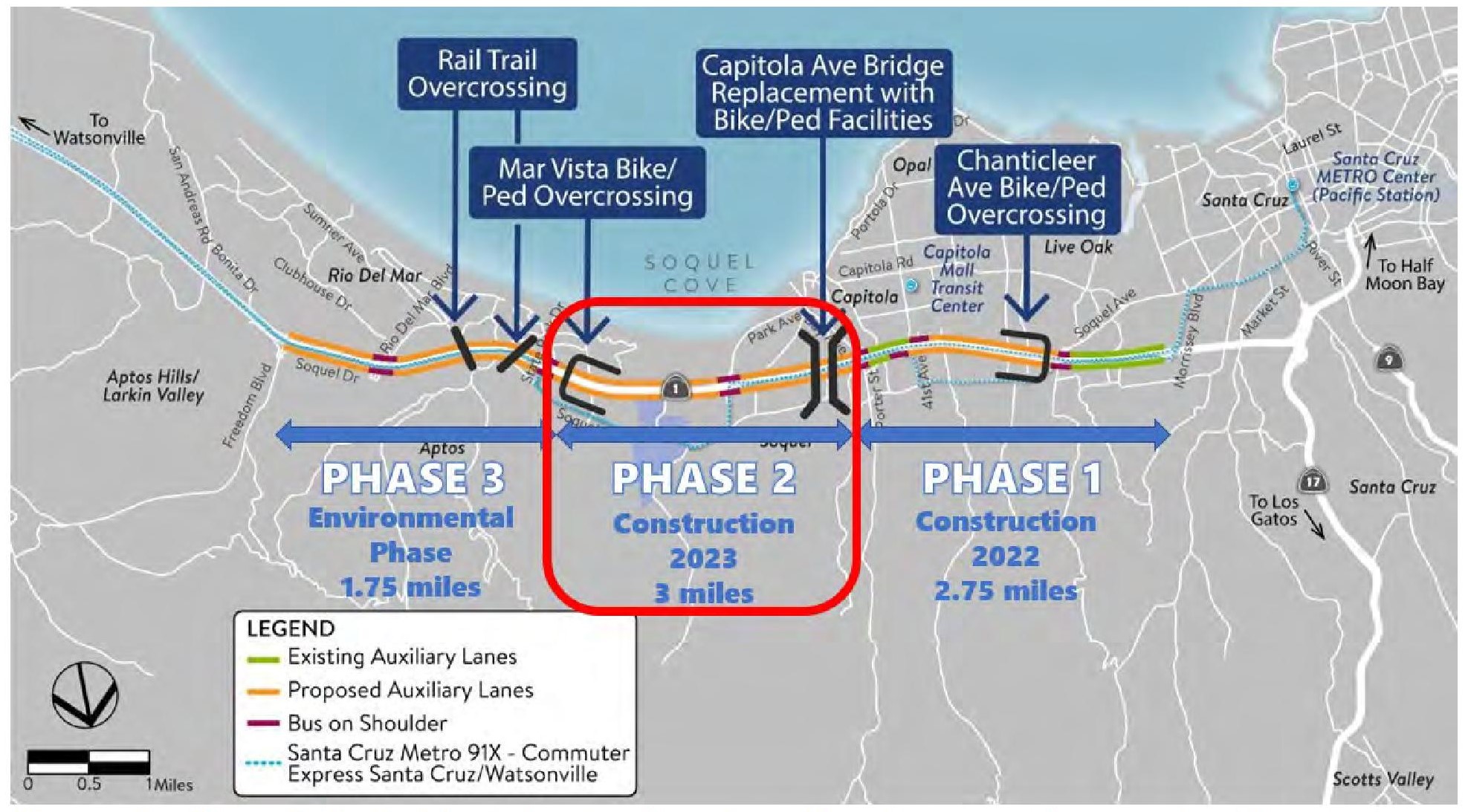
Highway 1 is expected to be widened from Freedom Boulevard to Morrissey Boulevard in three phases. New bridges are planned at Chanticleer Avenue, Mar Vista Drive and at two railroad crossings in Aptos. (Santa Cruz County Regional Transportation Commission)
The Highway 1 work has three phases.
Phase 1 from Bay Avenue to Morrissey Boulevard
The first part of work includes:
- A new bridge for cyclists and walkers over Highway 1 on Chanticleer Avenue in Live Oak.
- New “auxiliary lanes” on both sides of Highway 1 between 41st and Soquel avenues. Buses and other vehicles will be able to use the lanes. The highway is now four lanes in that stretch, and a new lane is expected to be added to each side.
- An improved median is expected to be built closer to the northbound lanes.
An engineer’s estimate of the project was $25.5 million in 2021. There were five bids for the Phase 1 work received in August. The lowest bid, from Granite Construction Co., came in higher than the engineer’s estimate, said Sarah Christensen, senior project engineer for the Regional Transportation Commission.
To cover the difference, commissioners on Thursday unanimously voted to allocate $1.8 million from Measure D revenue. State grants are expected to cover much of the rest of the project’s costs. Construction is expected to start this fall under Caltrans’ management.
Phase 2 from Bay Avenue to State Park Drive
The second phase of work includes:
- A new Highway 1 overcrossing for cyclists and walkers at Mar Vista Drive in Aptos.
- Bicycle and walker safety improvements on the Capitola Avenue bridge over Highway 1.
- Auxiliary lanes on both sides of Highway 1. Buses and other vehicles will be able to use the lanes.
Construction is expected to start in 2023, transportation commission staff said.
Phase 3 from State Park Drive to Freedom Boulevard
The third phase of the work includes:
- Auxiliary lanes on both sides of Highway 1. Buses and other vehicles will be able to use the lanes.
- Two new, wider Highway 1 bridges where the Santa Cruz Branch Rail Line crosses Highway 1. The tops of the bridges also are expected to be improved for cyclists and walkers as part of the rail-trail project.
- Two bridges for cyclists and walkers are planned for Soquel Drive at Valencia Creek and Soquel Drive at Aptos Creek. The tops of the bridges also are expected to be improved for cyclists and walkers as part of the rail-trail project.
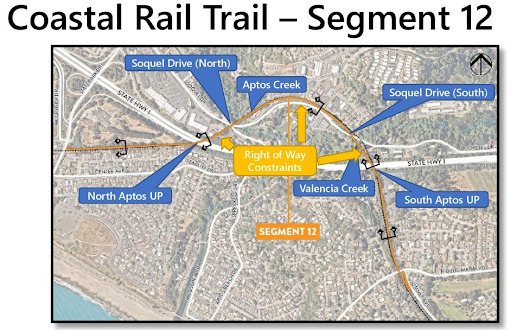
Segment 12 of the planned rail trail crosses Highway 1 twice. (Santa Cruz County Regional Transportation Commission)
Environmental work for the third phase is expected to finish in 2023. Design work is supposed to finish in 2025 and construction also could start the same year, Christensen said Thursday.
Christensen said the plan is to apply for some of the state’s $700 million in the state’s “congested corridors” program. Money from Measure D and “other local funding” also is expected to pay for the third phase.
“A major part of our delivery strategy is to advance projects to get them construction ready, because that makes us more competitive to get the funding,” Christensen said.
Highway widening critics
Daily Highway 1 traffic is caused in part by many jobs in the northern part of the county and a large share of housing in the southern part of the county, transportation planners have said.
Some critics of widening Highway 1 have pointed to studies from other areas that show about five to 10 years of traffic relief before congestion resumes to its prior level.
“Adding capacity to roadways fails to alleviate congestion for long because it actually increases vehicle miles traveled,” wrote Susan Handy, an environmental science and policy professor at UC Davis, in a 2015 policy brief. “Adding capacity decreases travel time, in effect lowering the ‘price’ of driving; and when prices go down, the quantity of driving goes up,” Handy wrote.
During Thursday’s transportation commission meeting, Commissioner Manu Koenig described the Highway 1 work as maintenance on a road that tens of thousands of residents use each day. As electric vehicles are added, Koenig said, “We have to transform Highway 1 as a facility to an all-electric, zero emission facility with more (public) transit on it.”
Guy Preston, executive director of the Santa Cruz County Regional Transportation Commission, said he hoped the highway work would keep drivers on Highway 1 rather than cut through neighborhoods during commute hours.
“Addressing the comments we heard earlier from the public, the irate drivers that are driving through our local roads will hopefully take the freeway — and stay on the freeway — and make our local streets safer for bikes and pedestrians,” Preston said.
Downtown Boulder Creek improvements
The Regional Transportation Commission on Thursday also told its staff to submit state and local grant applications to help cover safety improvements to Highways 9 and 236 in downtown Boulder Creek.
An $11.8 million plan to install new bike lanes, crosswalks and sidewalks and signs in downtown Boulder Creek could start in 2027, leaders told the Santa Cruz County Regional Transportation Commission at Thursday’s meeting.
About $2.4 million of the project is expected to come from the Measure D half-cent sales tax hike approved by Santa Cruz County voters in 2016, transportation leaders wrote in a report. About $9.4 million is still needed.
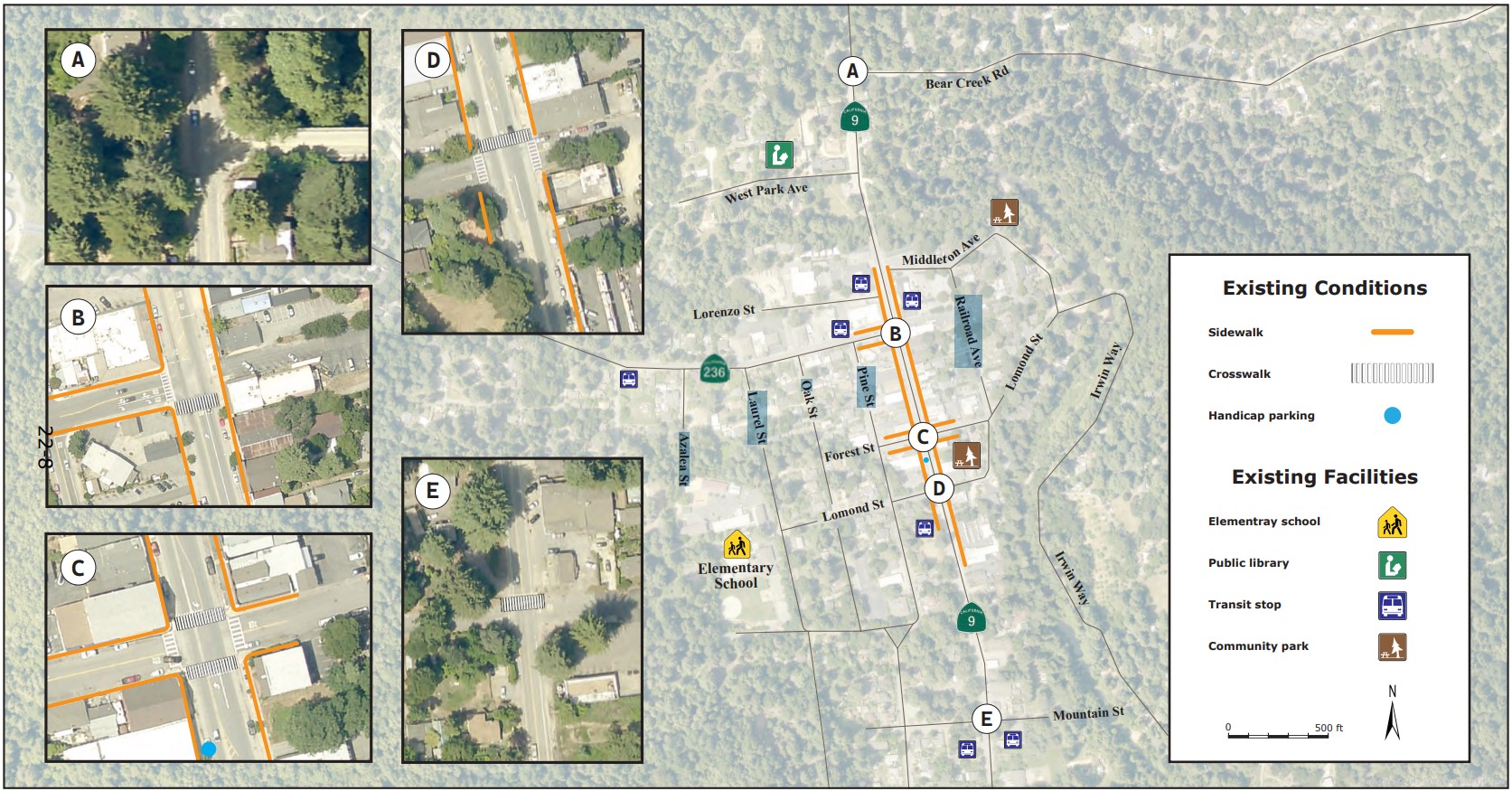
Highway 9 now lacks sidewalks in some areas of downtown Boulder Creek. (Santa Cruz County Regional Transportation Commission)
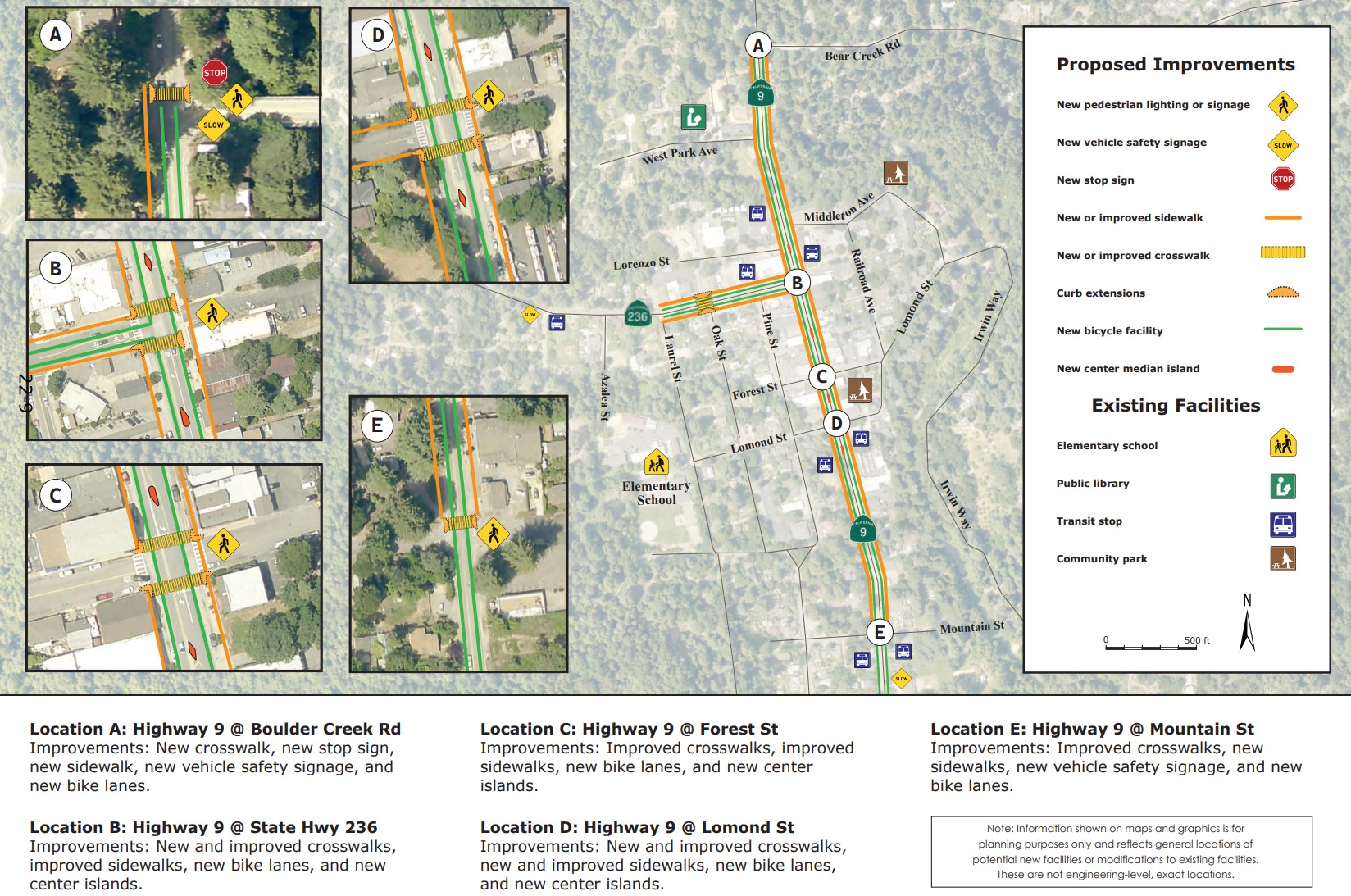
New bike lanes and sidewalks are planned for Highways 9 and 236 in downtown Boulder Creek. (Santa Cruz County Regional Transportation Commission)
Transportation leaders produced a planning document on the work this year. Environmental work is expected to start in 2023.
Virginia Johnson, an alternate for Bruce McPherson on the Regional Transportation Commission, said Boulder Creek residents have wanted these changes for at least a decade. She said Measure D in 2016 has gathered local money to leverage and win state grants.
“Now we’re actually getting down to projects, which is really exciting,” Johnson said at Thursday’s meeting. “It takes a long time to do all transportation projects, but this was the whole point of that (Highway 9) corridor plan and Measure D,” Johnson said.
Correction: Bay Avenue was misstated as Bay Street in an earlier version of this story.
Questions or comments? Email [email protected]. Santa Cruz Local is funded by members, major donors, sponsors and grants for the general support of our newsroom. Our news judgments are made independently and not on the basis of donor support. Learn more about Santa Cruz Local and how it is funded.
Santa Cruz Local’s news is free. We believe that high-quality local news is crucial to democracy. We depend on locals like you to make a meaningful contribution so everyone can access our news. Learn about membership.
Stephen Baxter is a co-founder and editor of Santa Cruz Local. He covers Santa Cruz County government.




